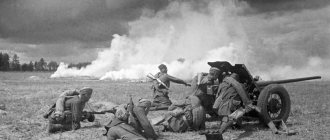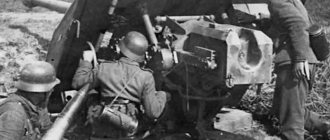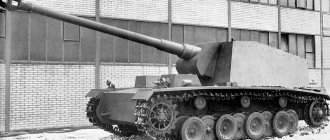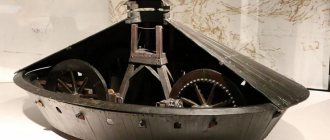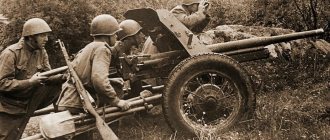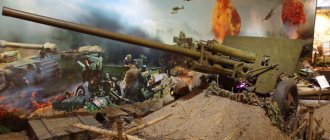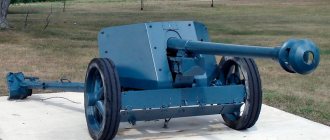The self-propelled gun was created at the end of 1941 with the aim of strengthening the anti-tank defense of German troops. The chassis of an obsolete German T-II tank with medium-diameter road wheels and a suspension with leaf springs was used as the base. In the middle part of the tank there is an armored conning tower, open at the top and rear. The wheelhouse was equipped with 75 mm or 50 mm anti-tank guns or modified captured Soviet 76.2 mm guns. The layout of the tank remained unchanged: the power plant was located at the rear, the power transmission and drive wheels were located at the front. Self-propelled anti-tank guns "Marder" II have been used since 1942 in anti-tank fighter battalions of infantry divisions. For their time, they were a powerful anti-tank weapon, but their armor was insufficient and their height was too high.
The German “Waffenamt” issued an order to develop self-propelled anti-tank guns of the “Marder” series at the end of 1941. There was an urgent need to improve the mobility of anti-tank guns by installing them on any suitable chassis due to the widespread use of T-34 and KV tanks by the Red Army. This option was considered as an interim solution; in the future it was planned to introduce more effective fighter tanks into service.
7.62 cm Cancer (R) AUF PZ. KPFW. II Ausf.D "MARDER" II - 76.2 mm anti-tank self-propelled gun Rak36(r) on the chassis of the Pz.Kpfw.II Ausf.D/E "Marder"II tank; tank destroyer on the chassis of the Pz.Kpfw tank. II Ausf. D/E, armed with a captured Soviet 76.2 mm F-22 cannon.
On December 20, 1941, it was ordered to install the captured Soviet 76.2 mm F-22 cannon of the 1936 model, designed by V.G. Grabine on the chassis of the Pz tank. Kpfw. II Ausf.D.
The fact is that Soviet designers, led by V.G. Grabin, back in the mid-30s considered it necessary to abandon the ammunition for the 1902/30 model cannon and switch to a different ballistics, with a more powerful charge. But the artillery commanders of the Red Army viewed the rejection of the three-inch ballistics as sacrilege. Therefore, the F-22 was designed for the 1902/30 model shot. But the barrel and breech were designed so that, if necessary, it was possible to simply bore out the charging chamber and quickly switch to shots with a larger cartridge case and a larger charge, thereby increasing the initial velocity of the projectile and the power of the gun. It was also possible to install a muzzle brake to absorb part of the recoil energy.
Sd.Kfz.132 “Marder” II Ausf.D/E (Sf) “Panzer Selbstfahrlafette” 1 für 7.62 cm Cancer 36(r) auf “Panzerkampfwagen” II Ausf.D1 und D2
The Germans duly appreciated the capabilities inherent in the design. The gun's charging chamber was bored to accommodate a larger cartridge case, and a muzzle brake was installed on the barrel. As a result, the initial speed of the armor-piercing projectile increased and reached almost 750 m/s. The gun could fight not only the T-34, but also heavy KVs.
successfully completed the installation of a Soviet cannon in the fighting compartment of the Pz.Kpfw.II Ausf.D. The hull, power plant, transmission and chassis of the base tank remained unchanged. Inside a fixed conning tower with low sides, mounted on the roof of the tank hull, a 76.2 mm cannon, covered with a U-shaped shield, is installed closer to the stern.
The Germans captured a huge number of F-22 cannons in good condition in the summer of 1941. A 75-mm German cannon shell penetrated 116-mm-thick armor from a distance of 1000 m at an impact angle of 90 degrees. Soviet captured cannons were modified to use ammunition for the PaK40 cannon. Shells fired from the modernized F-22 guns penetrated 108 mm thick armor from a distance of 1000 m at an impact angle of 90 degrees. Self-propelled anti-tank guns were equipped with ZF3x8 telescopic sights.
The Marder II tank destroyers with the F-22 cannon began to enter service with anti-tank fighter divisions of tank and motorized divisions in the early summer of 1942. The first Marders were received by the motorized division "Gross Germany". They were used on the fronts until the end of 1943, when they were replaced by more successful tank destroyers on the chassis of the Pz.Kpfw.38(t) tank.
The order for the conversion of 150 vehicles was completed by May 12, 1942. An additional 51 tank destroyers were converted from Pz.Kpfw.II “Flamm” tanks returned for repair. In total, at the enterprises of the Alkett and Wegmann concerns, from Pz.Kpfw tanks. II Ausf.D and Pz.Kpfw.II "Ramm" 201 "Marder" II tank destroyers were converted.
7.5 cm Pak40 AUF PZ.KPFW.II AF, “MARDER” II (sd.kfz.131) - 75-mm anti-tank self-propelled gun “Marder” II on the chassis of the Pz.Kpfw.II Ausf.F tank; tank destroyer on the chassis of Pz.Kpfw.II Ausf tanks. AF, armed with a 75 mm Pak40 anti-tank gun.
On May 13, 1942, at a meeting in the Wehrmacht Armament Directorate, the question of the feasibility of further production of Pz.Kpfw.II Ausf.F tanks at a rate of about 50 vehicles per month or switching to the production of 75-mm anti-tank self-propelled guns on the chassis of these tanks was considered. It was decided to reduce the production of the Pz.Kpfw.II Ausf.F and launch a tank destroyer on its chassis, equipped with a 75-mm Pak40 anti-tank gun, which had high performance and successfully fought Soviet medium T-34 tanks and even heavy KVs.
Sd.Kfz.131 “Marder” II Ausf.A/B/C/F(Sf) 7.5cm Cancer 40/2 auf “Fahrgestell Panzerkampfwagen” II (Sf) Ausf.A/B/C/F
The engine, transmission and chassis remained unchanged compared to the base car. A simple rectangular deckhouse, open at the top and rear, was located in the middle part of the hull. The gun is shifted forward.
"Marder" II with a 75-mm Pak40 cannon began to arrive in tank and motorized divisions of the Wehrmacht and SS in July 1942.
Self-propelled guns of the "Marder" series were based on the chassis of obsolete tanks, which were well mastered in production and operation, or on the chassis of captured French tanks. As mentioned above, self-propelled guns were armed either with German Rheinmetall-Borzing 75 mm PaK40 guns, or captured Soviet 76.2 mm F-22 divisional guns of the 1936 model.
Sd.Kfz.131 "Marder" II
The ideology of developing a self-propelled anti-tank gun was based on the maximum possible use of existing components and assemblies. From April 1942 to May 1944, the industry produced 2812 self-propelled guns. The first version of the self-propelled gun of the “Marder” series received the designation “Marder” II Sd.Kfz.132.
The Marder series vehicles are difficult to classify as design successes. All self-propelled guns had a very high profile, which made them easier to detect on the battlefield; the crew was not adequately protected by armor even from fire from rifle-caliber bullets. The fighting compartment, open at the top, created great inconvenience for the crew of the self-propelled gun in bad weather. Nevertheless, despite the obvious shortcomings, the self-propelled guns successfully coped with the tasks assigned to them.
Self-propelled anti-tank guns of the "Marder" series were in service with tank, panzergrenadier and infantry divisions, most often in service with divisional tank destroyer battalions, "Panzerjager Abteilung".
In total, in 1942-1943, MAN and Daimler-Benz produced 576 Marder II tank destroyers and another 75 were converted from previously produced Pz.Kpfw.II tanks. By the end of March 1945, Wehrmacht units had 301 Marder II installations with a 75-mm Pak40 cannon.
Tactical and technical characteristics of self-propelled guns of the “Marder” family
PzJg I
| Model | PzJg I |
| Military index | Sd.Kfz. 101 |
| t | |
| Chassis | PzKpfw I ausf.B |
| Combat weight, kg | 6 400 |
| Crew, persons | 3 |
| Speed, km/h | |
| - along the highway | 40 |
| — along the country road | 18 |
| Cruising range, km | |
| - on the highway | 120 |
| - on the ground | 80 |
| Gas tank capacity, l | 148 |
| Length, mm | 4 420 |
| Width, mm | 1 850 |
| Height, mm | 2 250 |
| Ground clearance, mm | 295 |
| Track width, mm | 280 |
| Engine | "Maybach" NL38 TKRM |
| Power, hp | 100 |
| Frequency, rpm | 3 000 |
| Weapon, type | PaK(t) |
| Caliber, mm | 47 |
| Barrel length, cal, | 43,4 |
| Beginning projectile speed, m/s | |
| - armor-piercing | 775 |
| - sub-caliber | 1070 |
| Ammunition, rds. | 68-86 |
| Machine guns, number x type | — |
| Caliber, mm | — |
| Ammunition, cartridges | — |
Marder-2 in the game "World of Tanks".
In the game, Marder-2 is one of the most dangerous PTs at its level, if not the most. Even despite this is not the first nerf. The AT still has the most penetrating gun on the level (thanks to the gun of its real prototype) with acceptable aiming and a good rate of fire, low visibility and sufficient maneuverability. A player who has only recently upgraded Marder-2 will not notice any serious shortcomings. However, those who remember the good old Marder-2 feel them quite strongly.
Marder II
| Model | "Marder" II | |
| Military index | Sd.Kfz.131 | Sd.Kfz.132 |
| Manufacturer | Alkett | Alkett |
| Chassis | PzKpfw II ausf.F | PzKpfw II ausf.E |
| Combat weight, kg | 10 800 | 11 500 |
| Crew, persons | 4 | 4 |
| Speed, km/h | ||
| - along the highway | 40 | 50 |
| — along the country road | 21 | 30 |
| Cruising range, km | ||
| - on the highway | 150 | |
| - on the ground | 100 | |
| Gas tank capacity, l | 170 | 200 |
| Length, mm | 6 100 | 5 600 |
| Width, mm | 2 280 | 2 300 |
| Height, mm | 2 350 | 2 600 |
| Ground clearance, mm | 340 | 290 |
| Track width, mm | 300 | 300 |
| Engine | "Maybach" HL62TRM | "Maybach" HL62TRM |
| Power, hp | 140 | 140 |
| Frequency, rpm | 3 000 | 3 000 |
| Weapon, type | PaK40/2 | PaK36(r) |
| Caliber, mm | 75 | 76,2 |
| Barrel length, cal, | 46* | 54,8 |
| Beginning projectile speed, m/s | ||
| - armor-piercing | 750 | 740 |
| - sub-caliber | 920 | 960 |
| Ammunition, rds. | ||
| Machine guns, number x type | 1xMG-34 | 1xMG-34 |
| Caliber, mm | 7,92 | 7,92 |
| Ammunition, cartridges | 9 | 600 |
* — The barrel length is given taking into account the muzzle brake. Actually the barrel is 43 caliber long
Mechanized cart for a captured cannon
The appearance of a tank destroyer based on the Pz.Kpfw.II was partly due to the rich spoils received by the Wehrmacht in the first months of the campaign on the Eastern Front. Among the equipment captured from the Red Army were about a thousand 76-mm F-22 divisional guns. The Germans adopted them under the designation FK.296(R), and the index FK 36(R) was also used. What attracted new owners to the captured gun was, first of all, its high anti-tank characteristics. At that time, it was the most powerful German anti-tank gun, successfully coping with any tanks.
The other side of the coin was the high combat weight of the F-22. In combat position it weighed 1,620 kilograms; carrying such a weight over rough terrain turned out to be no easy task. It is not surprising that the first proposals to install the FK 36(R) on a tracked chassis appeared back in August 1941. True, then the chassis of the Sd.Kfz.5 half-track tractor was used as a base.
76-mm F-22 divisional guns captured by the Germans in the summer of 1941. Many of them almost immediately began to be used by the Germans as anti-tank guns.
The Germans returned to the issue of “mechanization” of the FK 36(R) at the end of 1941. Then another problem was added to the need to increase the mobility of the gun on the battlefield. German light tanks, given the saturation of Soviet tank units with T-34 and KV-1 tanks, turned out to be practically useless. This was especially true for the Pz.Kpfw.II (F) flamethrower tanks. Meanwhile, in August 1941, production of the second series of flamethrower tank began, designated Pz.Kpfw.II (F) Ausf.B. Extremely controversial news from the Eastern Front already by the beginning of December cast doubt on the future prospects for using these tanks.
As a result, the Pz.Kpfw.II (F) Ausf.B became the first tanks of the Pz.Kpfw.II family for which the path to the front was closed. Although production of the vehicle continued in 1942, on December 20, 1941, the inspection of motorized troops (In 6) issued an order for a “self-propelled carriage” using the La.S chassis. 138 and a captured Soviet KF 36(R) gun. The Alkett company, by that time one of the leading developers of self-propelled guns, was chosen as the contractor.
One of the first samples of 7.62 cm Pak 36(R) auf Fgst. Pz.Kpfw.II(F) (Sfl.), spring 1942
The first prototype of a self-propelled gun, designated 7.62 cm Pak 36(R) auf Fgst. Pz.Kpfw.II(F) (Sfl.), was prepared on April 1, 1942. The gun, which was going to be installed on the Pz.Kpfw.II Ausf.D2 chassis, underwent a number of changes. A study of the design of the captured gun showed that it could be converted to use more powerful ammunition. The result was a gun known as the 7.62 cm Pak 36(R). The first such weapon was ready at the end of 1941. The Germans bored out its charging chamber for a new sleeve 716 mm long, identical to the one used in the 75 mm Pak 40 anti-tank gun (but not compatible with it). A significant increase in the charge required the installation of a two-chamber muzzle brake, which, however, not all guns received. The aiming mechanisms of the converted gun were concentrated on the left side, which significantly simplified aiming. A telescopic sight appeared. Both the carriage and the gun shield were redesigned. As a result, the most powerful anti-tank gun at that time appeared in service with the German army.
To simplify production, the Pak 36(R) gun shield was partially used on the swinging part of the 7.62 cm Pak 36(R) auf Fgst. Pz.Kpfw.II(F) (Sfl.). It was trimmed somewhat from the sides and side sheets were added to protect the crew.
The downside of the dense layout of the fighting compartment: to make a medium repair, a crane was required
We had to tinker a lot with the Pz.Kpfw.II Ausf.D2 chassis. The main problem was, oddly enough, the rational layout of the machine. It was good for a tank, but created difficulties when developing a self-propelled gun. It was not possible to place the gun closer to the nose of the chassis; the result was a very non-standard design. The creators of the self-propelled guns moved the gun as far as possible towards the stern; the floor of the fighting compartment became the over-engine plate. It is not surprising that the gun's ammunition load was only 30 rounds.
The placement of the gun in the rear of the vehicle determined the high height of 7.62 cm Pak 36(R) auf Fgst. Pz.Kpfw.II(F) (Sfl.) – it was 2.6 meters. To protect the gun crew from bullets and shrapnel, it was necessary to make a high deckhouse, open at the back and top. The commander moved to the radio operator's place. Despite all the alterations and increase in the size of the vehicle, its combat weight even decreased and amounted to 11.8 tons.
The small size of the fighting compartment forced us to make such boxes. They met quite often
In March 1942, without waiting for the completion of the first prototype, the military signed a contract with Alkett for the production of 150 7.62 cm Pak 36(R) auf Fgst. Pz.Kpfw.II(F) (Sfl.). The already produced 62 Pz.Kpfw.II (F) Ausf.Bs were sent for conversion into tank destroyers. According to initial plans, Alkett delivered the first 45 self-propelled units in April 1942, 75 in May, and the remaining 30 in June. In practice, Spandau worked much more quickly - by May 12, 1942, all 150 vehicles were ready.
By that time they had already been renamed Pz.Sfl.I f. 7.62 cm Pak 36. In 1942 alone, the new self-propelled gun was renamed 4 times, and in total its name changed 10 times.
In this case, instead of meshes, the rear fighting compartment is covered with sheets of metal
Separately, it is worth mentioning the second series of Pz.Sfl.I f. 7.62 cm Pak 36. The fact is that not all Pz.Kpfw.II (F) were lost forever. About 60 flamethrower tanks were under repair. A completely logical idea arose to convert them into tank destroyers. Wegmann from Kassel was chosen as the contractor. It was awarded a contract for the production of 60 sets of deckhouses and the conversion of a similar number of Pz.Kpfw.II (F) chassis, also known as Pz.Kpfw.II Ausf.D1.
Unlike Alkett, Wegmann did not work as quickly. The first 13 vehicles were converted in June 1942, 9 in July, 15 in September and 7 in October. Another 4 vehicles were converted in May 1943 and 4 in June. Thus, a total of 52 self-propelled guns were built on the Pz.Kpfw.II Ausf.D1 base, and the total production of tank destroyers using the La.S.138 chassis was 202.
The Battle of Stalingrad turned out to be very fruitful in terms of trophies. Among them were Pz.Sfl.I f. 7.62 cm Pak 36
In mid-February, the staff of a motorized battery of tank destroyers was approved, which included 9 self-propelled guns. In practice, the composition of such units was somewhat different. On March 9, the Supreme Command of the Army (OKH) drew up a supply plan for 7.62 cm Pak 36(R) auf Fgst. Pz.Kpfw.II(F) (Sfl.). The Grossdeutschland division and the 1st SS division each received 18 vehicles (2 batteries of 9 self-propelled guns), and the 10th, 16th, 29th and 60th motorized divisions, as well as the Wiking SS division, they received a battery with 12 cars in each. The 16th Motorized Division was the first to receive 12 vehicles. As of June 28, the troops had 133 Pz.Sfl.I f. 7.62 cm Pak 36. Of this number, 33 vehicles ended up in the 559th, 611th and 670th tank destroyer battalions (11, 12 and 10 vehicles, respectively). Another 12 vehicles later ended up in the 525th Tank Destroyer Battalion.
Captured self-propelled gun at the NIBT Test Site, summer 1943
A very specific chassis was one of the reasons for the mixed reports on the use of the Pz.Sfl.I f. 7.62 cm Pak 36. The very first battles showed that the idea itself of installing the 7.62 cm Pak 36(R) on a self-propelled chassis was correct. According to reports, even KV-1s were hit at a distance of 1200–1400 meters. True, the units complained about some problems in the operation of the guns. As for the chassis, the situation was somewhat different. The self-propelled gun was considered too high, which made it a convenient target. In addition, a number of units considered a crew of 4 people to be insufficient. Judging by reports and photographs, in some units the roles of radio operator and commander were separated. At the same time, there was not enough space in the fighting compartment for the third crew number, and there was no place for him to sit.
She's on the left side
The small volume of the fighting compartment forced the personnel of some units, for example, the 611th tank destroyer battalion, to make boxes for personal belongings on the outside. Quite often, problems arose with the reliability of the chassis. Car maintenance was turning into a headache. To get into the engine compartment, it was necessary to remove the gun, and to dismantle the gearbox, almost half of the car had to be disassembled.
In Soviet documents, the vehicle was described as a “Self-propelled 76 mm cannon based on the M-1F flamethrower tank.”
Of the 194 Pz.Sfl.I f. 7.62 cm Pak 36, produced in 1942, by April 20, 1943, 16 remained in service. The reason for such high losses was, among other things, the successes of the Red Army in the winter of 1942–43. Quite a few Pz.Sfl.I f. The 7.62 cm Pak 36 was captured at Stalingrad. At least one vehicle ended up at the NIBT Test Site in Kubinka.
Judging by the dynamics of the availability of vehicles in units, in 1943 they were rarely used in battles. At the end of 1943, their number, due to repaired vehicles, increased to 20. By this time, these self-propelled guns received the more famous designation Marder II, first used on November 29, 1943. As of the end of December 1944, 8 of these vehicles remained in service. On March 15, there were 6 of them, 4 of them in the 58th Infantry Division.
Additional modules and skills.
Based on the application tactics, we select additional modules. They will be:
- rammer
- mixing
- stereo tube
Selecting additional skills for the crew:
- commander: camouflage, 6th sense, military brotherhood.
- gunner: camouflage, sniper (taking into account the penetration of the gun), military brotherhood;
— driver: camouflage, virtuoso, military brotherhood.
Why this is so: with the help of the rammer, we bring the already decent damage per minute indicator to more than impressive; We set the alignment to ensure that the gun has time to fully align no later than the reloading period ends; The stereo tube allows you to realize the potential of the weapon. Camouflage for all crew members allows them to remain completely unnoticed, this is very important when maintaining a direction or defending a base; The 6th sense will allow you to escape from potential fire in time; a sniper is relevant when penetrating such and such a weapon, the projectile of which is capable of not only penetrating armor, but also damaging the insides of the enemy; the virtuoso will improve the indicators of the PT turn time, which is important if close maneuver combat was forced on you.
Advantages and disadvantages. Application tactics.
Let's move on to highlighting the main advantages and disadvantages that will guide the tactics of using Marder-2 on the fields of World of Tanks:
Advantages:
— excellent penetration allows you to feel confident in battles of any level where the PT falls;
- visibility, which can only be dreamed of by a higher-level AT, allows the Marder to realize an advantage in weapons;
- low visibility allows the Marder, with the correct positioning in cover, to fire while remaining completely unnoticed. Thus, the PT is capable of holding the direction almost single-handedly;
— sufficient maneuverability allows you to take advantageous positions on a specific bridgehead in time, and also makes it more difficult for the enemy to maneuver into Marder’s side;
— the ratio of damage to rate of fire even now allows you to feel confident even against 2-3 enemies at a distance.
- an excellent horizontal aiming angle allows you to literally fire from around the corner. That is, after the shot, all that remains is to turn the body a little in order to completely hide from the enemy’s view.
Flaws:
— the small thickness of the armor and the irrational angle of its inclination, which almost eliminates even the chance of a rebound;
— danger of setting the vehicle on fire with a shot in the forehead (presence of a transmission in the middle);
—…actually two nerfs in a row;
Application tactics:
Based on the set of advantages and disadvantages, Marder-2 will feel equally useful both in maintaining direction and in supporting an allied breakthrough.
In the first case, for example, thanks to good visibility, as well as penetration, damage and rate of fire of the gun, Marder-2 is capable of defending a base from a distance from cover. In the event of an allied breakthrough, Marder-2 will become indispensable, hitting enemies at dawn thanks, again, to its weapon. It will be much easier for the allies. Due to the weak armor, as well as the front location of the transmission, Marder-2 is extremely painful to bear the role of a pioneer. It can be like this only in the most extreme cases.

